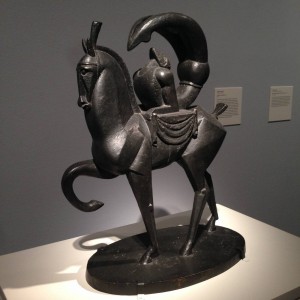
That’s probably your face as you read this title. To be sure, our typical experiences with research usually have little to nothing to do with social media. But we have to remember that, at the end of the day, research is interesting because of its power to change lives. It’s our job as researchers to show how that can happen — by making our work accessible and relevant. And who knows how to be accessible and relevant better than social media experts?
Somewhat surprisingly, that’s where art comes in. Princeton’s recent Social Media Day started with an interactive demonstration—an early morning tour of the collection in Princeton University Art Museum, with the Metropolitan Museum of Art’s Chief Digital Officer, Sree Sreenivasan, offering tips on how to share art on social media. This tour was modeled after the “#emptymet” tours that showcase the Met’s artwork online, which helps maintain public interest in the works.
So taking a page out of that book, let’s recap the best quotes from Social Media Day, as illustrated by artwork from the Princeton University Art Museum.
- “We have a maximum of 30 seconds to produce something that will be of broad interest to as many people as possible.” -Professor Jeff Nunokawa, Department of English
In reality, 30 seconds might be an overestimate. You pretty much have to capture someone’s attention before they get the urge to pull out their phone. You don’t want to use a flashy title to trick your audience, but you don’t want to be overly humble and downplay your results, either. After all, if you’re not convinced your results matter, it’s hard to convince other people that your work matters, too.

- “To help others understand the world they live in, we have to understand it first.” -Robert Durkee ’69, Vice President and Secretary of Princeton University
In other words, make sure you actually know your stuff. For instance, it’s useful and fast to default to jargon and buzzwords that sounds good, but you should also be able to elaborate on key words and concepts when asked. You don’t want to end up in an awkward position where you’re asked a question about something and can’t explain it, or worse, say something that simply isn’t true.

- “We should strive to think about how to imagine the world differently and offer people alternative perspectives to widely known topics.” -Professor Jill Dolan, Dean of the College
Your work may very well end up challenging current norms, traditions, and methods of doing things—and that’ll make a lot of people uncomfortable. But that doesn’t mean you should shy away from pursuing it.

- “We need to continue to be curious about the world, even about things that seem routine.” -Tom Weber ‘89, Executive Editor, Time Magazine
There’s so much in the world that we still don’t understand, but we can’t learn more if we take it all for granted. Don’t lose the ever-pressing sense of curiosity and wonder. Some of it may lead you down stray roads that seem completely wrong — but if we never make mistakes, we’ll never learn.

- “We don’t have to be so serious about our work all the time. We need to ask ourselves: how can we be relevant?” -Sree Sreenivasan, Chief Digital Officer, Metropolitan Museum of Art
Again, people care about research because it’s 1) relevant to them and 2) it’s interesting. And it’s possible to make research interesting without sacrificing the integrity and true nature of the work—it just takes some creativity.

You can check out a full recap of Social Media Day here, and be sure to look for these paintings and sculptures the next time you’re in the Art Museum!
-Stacey Huang, Engineering Correspondent

